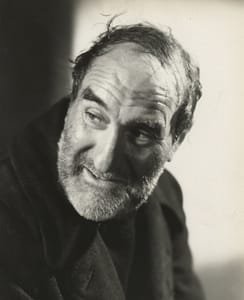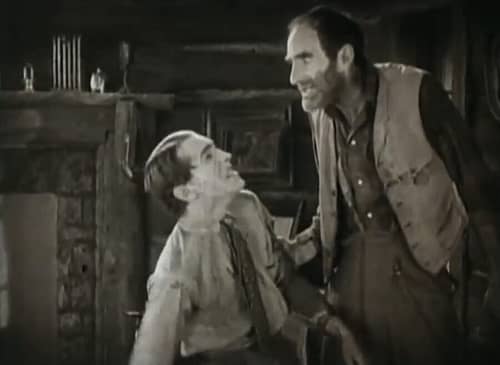
In his nearly fifty film roles, Ernest Torrence perfectly exemplifies the unique skill set required to succeed as a character actor. A towering 6’4″ with a rugged, grizzled face, Torrence backed up his unique physicality with a rare mixture of humor and villainy. While he played mostly villains, old curmudgeons, and colorful side characters throughout the 1920s and the early years of sound, he was never pinned down to just one character type. He starred in some of the era’s biggest box-office smashes sharing the screen with, and often stealing it from them too, such stars as Richard Barthelmess, John Gilbert, Clara Bow, Buster Keaton, and Claudette Colbert.
Torrence has always been one of my favorite actors of the 1920s. Some might only know him as Buster Keaton’s stern, disapproving father in Steamboat Bill, Jr. (1928), but Torrence enjoyed more than a decade of success as a prolific character actor. Whether playing a sadistic country bumpkin, a love-stricken lumberjack, or a stern fatherly steamboat captain, Torrence always managed to craft unique characters infused with pathos, humor, and a mean streak. Never afraid to outshine his co-stars for a laugh or even a sneer from the audience, Ernest Torrence lifts up every movie and scene luckily enough to have him.
Ernest Torrence
Torrence, born Ernest Thayson Torrence-Thomson in Edinburg in 1878, debuted in show business touring with an opera company across Scotland. Dedicating himself to acting after dealing with several issues with his vocal cords, Torrence broke out on the Broadway stage in the 1910s alongside his brother David. Although he played bit parts in two now-lost films prior, he would fully dedicate himself to the screen following his triumphant success in Henry King’s 1921 Tol’able David.
Even in only his third screen role, Ernest Torrence proves his ability to steal the screen and craft a truly unique character as the villainous Luke Hatburn. While Barthelessmess’ David—a scrawny youngest child aiming to prove his manhood to his family and sweetheart— provides the heart of the film, Torrence’s Luke—a violent outlaw terrorizing David’s small town and his sweetheart— strikes fear into the audience and provides an antagonistic violent threat to our hero.
Torrence quickly rose to character actor stardom as the maniacal Luke Hatburn.
From sadistically torturing animals to crippling David’s brother in a fight, Torrence carries out his characters’ various aggressions and violence with humorous glee. It’s a truly terrifying turn that provides our hero with a formidable Goliath to face up against in the film’s climactic fight. His character’s introductory title card sums his character up perfectly as one “whose peculiar humor was to destroy whatever he encountered”.
Torrence’s subsequent roles incorporated more comedy and pathos into the villainous characters he played. Look no further than his turn as Captain Hook in 1924’s Peter Pan. He brings a bit of camp to the role, perfecting aligning with the fantastical elements of the story. (A film that starts off with a human in a dog suit is definitely in need of more camp!). Torrence walks a fine line between striking fear in our cadre of young children and cowardly running from a hungry crocodile (also played by a human in a suit). He knows just the perfect place to add a grand gesture and snarl or an exaggerated look of fear and wonder.
Torrence brings the right amount of camp to the role of Captain Hook with a perfect sense of timing (pun intended).
In films like The Covered Wagon (1923) and Mantrap (1926), Torrence showcased his unique flair for comedy. One familiar with the majority of his screen work would be surprised to not only see him star opposite Clara Bow but to play her husband as well! But that’s exactly his role in Mantrap as a lonely, middle-aged bachelor trapper who goes to town and convinces Bow to marry him and move out to the woods. In this romantic comedy, Torrence shines as a bumbling yet good-hearted woodsman in the need of a woman’s company perfectly complimenting Bow’s flirtatious onscreen persona.
Adeptly striking fear into the audience and providing well-time comedic relief is already a lot to brag about but Torrence also routinely proved his dramatic ability. Playing the apostle Peter in DeMille’s religious epic The King of Kings (1927) provided him the perfect opportunity to show off his dramatic chops. Introduced as the giant apostle quick of temper with a soft heart, Torrence wonderfully portrays Peter’s transformation from a hotheaded believer to a mature leader. He did so well that Photoplay singled him out as one of its standout performers of the month.
Torrence shows off his skill for drama as the apostle Peter.
While his most well-known roles are during the silent era, he successfully transitioned to sound films adding his distinctive voice to several roles in the Pre-Code era. Of his early sound roles, his work as Professor Moriatoty’s opposite Clive Brook in 1932’s Sherlock Holmes stands out for his delicious villainy.
Shortly after completing his scenes as a smuggler in James Cruze’s I Cover the Waterfront (1933), Torrence died following complications from gallbladder surgery at the young age of 54. Appearing many years his senior in the majority of his roles, Torrence could have continued securing roles and stealing scenes from Hollywood stars for several more decades after proving his mettle in sound pictures.
After his dozens of roles, his turn in the lesser-known gem Desert Nights (1929) alongside John Gilbert—in his final silent role— and Mary Nolan perfectly exemplifies Torrence’s unrivaled skill as a character actor during his time in Hollywood. Torrence is at the top of his game in a role that allows him to showcase his humor, villainy, and dramatic chops all in one.
At first, his character is a fine gentleman, clean-shaven, and capable of wooing any business deal. When we discover he is instead masquerading as an upper-class man, Torrence turns on his scowl and grum persona. As the three stars traverse the Kalahari Desert, Torrence pulls out all the stops portraying a thirsty, depraved madman. Even alongside a dynamic John Gilbert and alluring Mary Nolan, Torrence demands attention every time he appears onscreen.
The rare opportunity Torrence gets to be a little bit classy.
Like any of the dozens of character actors that would follow in Ernest Torrence’s footsteps, he livened up the screen in numerous classics. Strengthening some of the era’s highest-grossing films (The Covered Wagon to The Hunchback of Notre Dame), the biggest star vehicles (Mantrap and Steamboat Bill, Jr.), and critically acclaimed and lasting cinematic achievements’ in Tol’able David and The King of Kings, Torrence leaves an immovable legacy in some of the best-remembered films of silent Hollywood. What a character indeed.
This post is part of the 11th Annual What a Character! Blogathon. For other great profiles of great character actors like Ernest Torrence, visit the blogathon’s main page.










I’ve only ever seen Ernest Torrence in Steamboat Bill, Jr. – and he was fabulous, of course. I didn’t realize he had such a varied and prolific career in the silents. Thanks for sharing his work with us.
Thanks! He works so well with Keaton in Steamboat Bill, Jr. I definitely need to watch more of his sound work but can definitely vouch for his great silent work.
Boy oh boy – talk about Norma Desmond’s “we had faces” comment. This is a face you don’t forget – ever! However, I must admit I had a bit of a hard time thinking Clara Bow would go for him in “Mantrap.” Come to think of it, Percy Marmont wasn’t much, either. That girl needed to get out of that town! Great post about a truly great and unique character.
Truly a jawline for the ages! Agreed. Pretty sure Elinor Glyn wouldn’t have said Torrence had IT haha
So much fun! Torrence was a fantastic Captain Hook